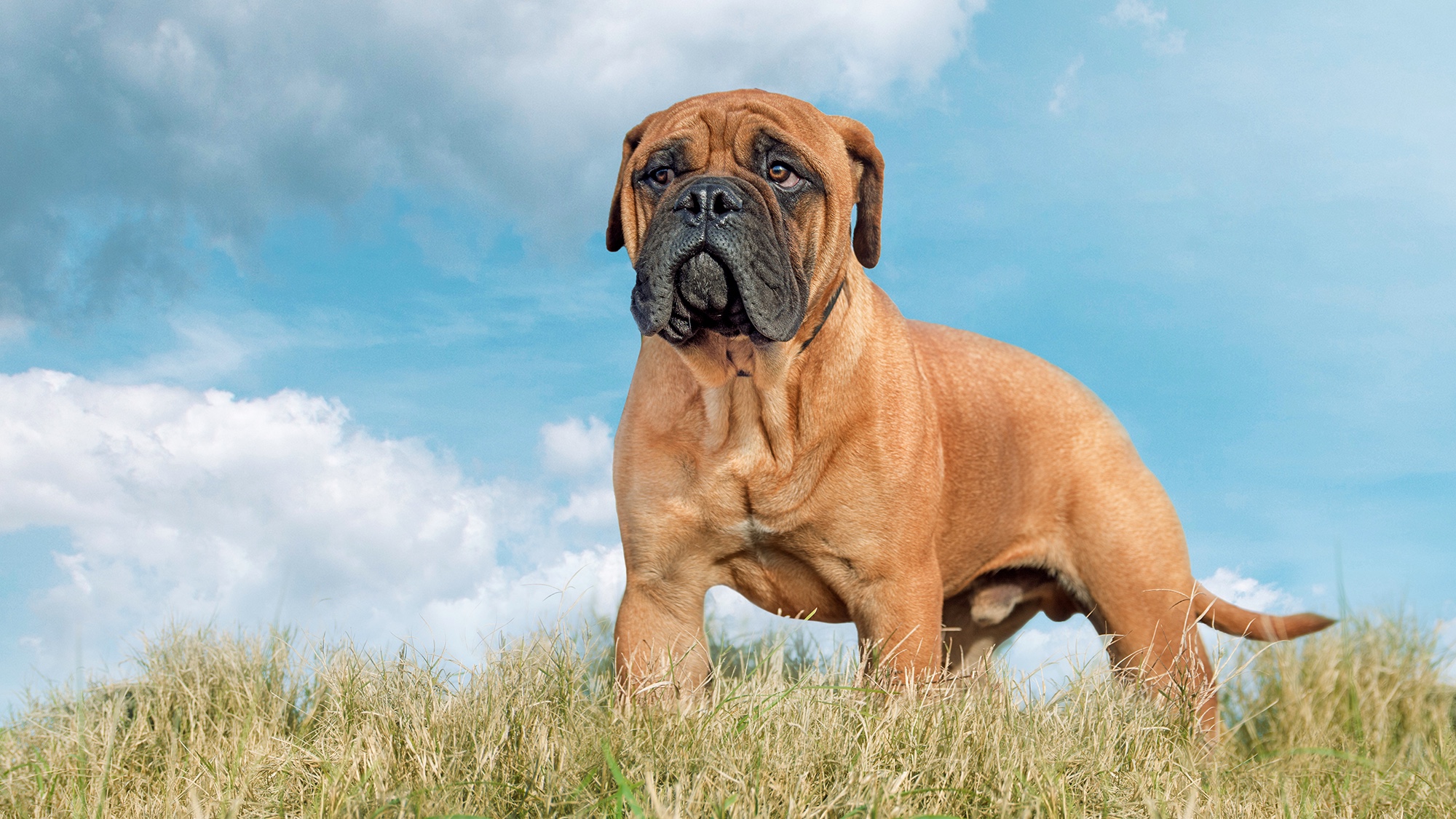7 larger than life Bullmastiff facts
As these Bullmastiff facts reveal, this is one big dog with one seriously big heart

This breed may have a slightly intimidating name and look like a big, strong brute, but as these Bullmastiff facts reveal, under that muscular exterior beats a gentle heart. Bullmastiffs are loyal, obedient and a well-trained one can be extremely docile. They’re large and loving, which makes them great around children, although they can accidentally pose a risk to toddlers and babies due to their size.
They make ideal pets as they can be happily left in an apartment as long as they get playtime when you’re around, have short, easily-groomed hair and are distrustful of strangers, which makes them a good guard dog. They’re nicknamed the silent watchdog as they aren’t big barkers, which is another reason that makes them ideal for apartment life.
But there’s so much more to Bullmastiffs than their perfect pet credentials. Find out what with these seven Bullmastiff facts.
1. They make great guard dogs
It probably won’t surprise you to know that Bullmastiffs can trace their origins to a breeding program between English Mastiffs and Old English Bulldogs – hence the name. They were first recorded in the 1860s, used by gamekeepers to keep poachers at bay. The Mastiff provided the powerful build, while the Bulldog was responsible for the aggression. They were fast, had excellent tracking skills and became known as the Gamekeeper’s Night Dog. Over the years the aggression has been bred out of them, but they still retain that muscular frame that is now just used for chasing tennis balls rather than poachers!
2. Its bark is as non-existent as its bite
The traits that made the Bullmastiff such an effective Gamekeeper’s assistant all those decades ago are also what make it such a good pet today. They were trained not to bark or bite, but to pin down any assailants until the authorities arrived. These days it just means that they are nice and quiet around the home and are unlikely to bite or snap at any intruder or child that hasn’t learned how to play nicely yet.
3. They’re drool-breakers
One thing that owners of a Bullmastiff would have to look out for is drooling. This breed drools a lot, so be aware of that if you’re particularly house-proud. On the other hand, it doesn’t shed or molt anywhere near as much as longer-haired dog breeds. The Bullmastiff also doesn’t need as much exercise as you might think. Two or three short walks a day would be plenty for this breed as it has moderate energy levels. It also doesn’t like the heat, so consider this when walking them on sunny days.
4. It’s had a Rocky life

The Bullmastiff has quite a history of celebrity ownership. Sylvester Stallone’s adopted Bullmastiff Butkus was given a role in Rocky and Rocky II. He didn’t have to test his acting chops much, as he played Stallone’s dog Butkus! Christina Aguilera, Marlon Brando and Jon Bon Jovi are also Bullmastiff owners, while the breed was first brought to the USA by billionaire John D. Rockefeller back in the 1930s. He imported them to act as guard dogs for his New York mansion Kykuit to deter poachers and kidnappers.
Get the best advice, tips and top tech for your beloved Pets
5. They have a great track record
The Gamekeepers of the 1860s and Rockefeller’s security team of the 1930s were clearly on to something. Today Bullmastiffs are commonly used as police dogs, due to their brilliant sight and smell skills, enabling them to be highly effective trackers. Their hefty frame and intimidating stature certainly don’t hurt either. One of their best traits, however, is that they are intelligent dogs, easily trained as long as it starts early. Having said that, they’re not the smartest pooches on the planet, ranking 127th out of 137 breeds on the Coren scale. But as long as they’re given limited instructions and trained to obey them well, they’re superb security animals.
6. They can suffer from health problems
Like many dogs, especially those on the larger side, the Bullmastiff does suffer from a number of health problems. These include tummy bloating and twisting, hip dysplasia, breathing problems and eye issues. Their average life span is less than ten years, so make sure you factor this in when buying or adopting one.
7. They love you but they aren’t fans of other dogs and cats
Just like your classic cartoon dog, Bullmastiffs love their human companions but aren’t always such big fans of cats – or other dogs for that matter. Bullmastiffs are likely to chase them thanks to their natural instincts, so this is certainly something you’d need to be conscious of if you have another pet in the family or plan to get one. Other than that, Bullmastiffs are big, loveable softies with a huge heart and certainly a great companion for families, couples and individuals alike.
Marvelous mascot
So there you have it. Bullmastiffs are loving, strong, gentle and loyal, all traits that many humans would love to have. In fact, a Bullmastiff called Swagger became the mascot of the Cleveland Browns in 2014 and was then succeeded in the role by his son, Swagger junior. So why not take a look at whether you’d like a Bullmastiff to be your very own mascot?
Enjoyed these facts? Here are our favorite interesting dog facts for you to enjoy, and here’s how much it costs to own a bullmastiff

